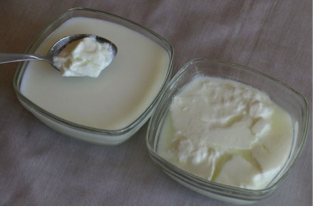Both are milk-born products, yogurt and curds are often considered the same. Yet, the two are different in several aspects, like processing, usages, benefits, etc. A key difference between curd and yogurt is in their production, which further leads to differences in nutritional content, benefits, and other uses.
Both curd and yogurt are great for gastrointestinal health and building strong bones, and there are many benefits to be gained from incorporating these products into a daily diet. While they may have a similar appearance, it is important to remember that curd and yogurt act differently in recipes and shouldn't be substituted for one another. Keep reading for more specific details on the difference between curd and yogurt.
Curd vs. Yogurt: What Are They?
 Yogurt is a dairy product that is created by bacterial fermentation of milk using "yogurt cultures". The bacteria cause fermentation of lactose and produce lactic acid.
Yogurt is a dairy product that is created by bacterial fermentation of milk using "yogurt cultures". The bacteria cause fermentation of lactose and produce lactic acid.
Curd is a dairy product processed by curdling milk with rennet or an acidic substance (edible) like vinegar or lemon juice, and then draining off the liquid and allows it to sit.
Difference Between Curd and Yogurt
1. Nutrition
Nutrition Charts for Curd and Yogurt | |||
|---|---|---|---|
|
Serving Size: 100 grams |
|||
|
Nutrition |
Amounts in Yogurt |
Amounts in Curd |
|
|
Calories |
95 |
98 |
|
|
Total Fat |
1.2 g |
4.3 g |
|
|
Protein |
11 g |
32 g |
|
|
Carbohydrates |
47 g |
65 g |
|
|
Vitamins |
Vitamin A |
4 international unit |
140 international unit |
|
Vitamin B2 |
0.278 mg |
0.25 mg |
|
|
Vitamin B12 |
0.75µg |
0.35 µg |
|
|
Vitamin E |
0.01 mg |
0.08 mg |
|
|
Minerals |
Calcium |
110 mg |
83 mg |
|
Iron |
0.07 mg |
5.25 mg |
|
|
Sodium |
36 mg |
1.25 mg |
|
|
Zinc |
0.52 mg |
0.25 mg |
|
2. Production
The key difference between curd and yogurt is how they are made. Yogurt is made through fermentation of lactate to lactic acid by bacteria cultures naturally found in dairy products, whereas curd is fermented by adding an acidic liquid such as lemon juice or vinegar, and allowing the milk to curdle.
Dating back to old days, records show that ancient cultures of India and Iran created yogurt as far as 500 B.C. Curd was likely discovered accidentally when old milk curdled.
3. Benefits
While the two appear to be very similar, yogurt and curd provide different benefits when consumed regularly.
- Benefits for Whole Health
When it comes to the health benefits, due to the similar contents, their health benefits can overlap in several aspects.
As for yogurt, it helps to prevent osteoporosis, control cholesterol levels, reduce the risk of high blood pressure, improve the gut health, and cure vaginal infections. Yogurt also boosts the immune system, which further helps with healing cough and cold; it also strengthens the gums and prevents cavities.
Curd helps to heal intestinal infections and yeast infections, and to control blood pressure and cholesterol, protecting against heart diseases. The presence of calcium aids in bone health, strengthens teeth, and reduces the risk of cancer. In general, curd is a remedy for stress and anxiety, boosts the immune system, improves digestion, provides energy, and stimulates the brain.
- Benefits for Hair
Yogurt provides relief for itchy scalp, reduces dandruff, hair fall, and split ends, and also acts as an excellent conditioner. Curd can also be a great conditioner, and also increases hair growth and improves dry and rough hair.
- Benefits for Skin
Yogurt is an excellent remedy for skin problems and sunburns. It acts as a natural moisturizer, adds brightness to skin, exfoliates dead skin, fights pimples and acne, and reduces blemishes, dark circles, skin discoloration, and the effect of anti-ageing. Yogurt can also be used as a homemade facial mask.
When you apply curd to skin, it can exfoliate dead skin, making skin glowing and flawless, and you can expect a softer and smoother skin.
4. Usages
Both yogurt and curd can be eaten plain or eaten with added salt or sweeteners. Yogurt is commonly used in creating beverages such as the Indian lassi or chaas, or is used to replace heavy cream in many recipes. Yet, curd is more often used in desserts and served in sandwiches or salads.
More Facts About Curd and Yogurt
Much of the confusion over the difference between curd and yogurt is nominal – they are often called the same thing without understanding the differences. For instance, many believe that curds can act as a substitute for plain yogurt in recipes, but this is not so. In India, curd refers to the yogurt which acts as a meal finisher with buttermilk. A possible replacement for yogurt and curd is sour cream, which has a similar appearance, but there is much fat in sour cream and doesn't have same health benefits.
Another misconception is that curd comes from buffalo milk, which can be commonly used in some parts of the world, but this is not the main defining feature of curd production.
